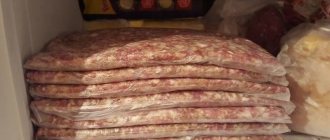Fresh baked goods delight with their softness and aroma, but they become stale very quickly. Sometimes huge stocks of bread accumulate at home. I want to preserve it somehow. An easy way is to make crackers. But they are not suitable for every dish. Easier, faster to freeze. Even in Gaidar’s work “Chuk and Gek” they ate frozen rolls. How relevant is it to preserve product in a chamber?
Let's find out whether it is possible to freeze bread, why they do it, what rules exist. At the same time, we’ll tell you how to return a soft and fragrant bun.
Why freeze bread
You can freeze not only berries, meat, and fish. Bakery products are often subjected to this procedure. Today, many supermarkets offer fresh baked goods. Most work on semi-finished products.
When properly frozen, bread completely retains its taste and aroma. This is a great way to keep baked goods fresh for a long time. If the technology is broken, the product quickly loses its properties, becomes wet, and acquires an unpleasant odor. It cannot be stored for a long time and will definitely not bring any benefit. You can also freeze sour cream and even birch sap.
Do you store bread in the freezer?
Not really
Why freeze bread:
- prolongation of freshness. Rare, expensive, tasty types of bread are easier to store in the freezer. Under room conditions, the product changes the very next day;
- save the surplus. It’s a pity to throw it away, sometimes there’s no one to give it to;
- convenient supplies. Freezing will help if you forgot to buy some bread after work, you returned from vacation, the store near your house is not open, or guests suddenly came.
You can freeze white, dark bread, buns, baguettes, and any other baked goods. The shelf life reaches six months. It is advisable to use it within a month. Defrost in an oven, double boiler, or at room conditions.
Freezing rules
In our country, bread has long been treated with great respect. Even when it starts to go stale, you don’t dare throw it away. Usually in these cases, housewives make crackers and croutons from bread. But if there is no use for the fresh product yet, it is better to freeze its excess and thereby save it from spoilage. Freezing bread is not difficult, but you need to know some rules.
- Under no circumstances should you freeze hot, freshly baked bread, as it will freeze very hard and will be wet after defrosting.
- You should also not put an old, already stale loaf in the freezer. Subsequently, it will turn out to be too hard, and its taste may change.
- You need to freeze the bread in such portions that after defrosting you can eat it all. Bread cannot be re-frozen.
- Regular bread is great for freezing, but tender, soft rolls do not tolerate frost as well. Therefore, it is better not to subject buns with a loose consistency, fluffy loaves and airy biscuits to this procedure.
How to freeze bread in the freezer for storage
In addition to bread, you can freeze Easter cakes, buns, rolls, and loaves. Absolutely sealed packaging is required. Immediately set the minimum temperature for rapid freezing. Next, we’ll tell you how to keep bread fresh for a long time in the freezer.
White
White baked goods tolerate freezing well. The more baking it contains, the better the taste is preserved.
How to freeze, instructions:
- Cut the loaf into slices. We wrap small buns immediately. We divide the baguettes into several parts.
- Wrap with cling film and make several layers. Or place it in a bag, squeezing out excess air.
- All that remains is to place it on the shelf of the camera and freeze it.
When using a whole loaf, we recommend that you first wrap it in film, then additionally place it in a thick plastic bag and tie it.
Black
Bakery products made from rye flour with fillers are less resistant to storage at sub-zero temperatures. Nuts, dried fruits, and other healthy additives release moisture after thawing. The crumb may spoil. Therefore, you need to freeze only in pieces. When thawing and warming up, excess moisture will immediately evaporate.
The technology is similar - we wrap the slices in film or a bag. Can be placed in a vacuum bag, remove air. We send it to the chamber and freeze it.
After freezing, the glycemic index of bread becomes lower. Starch is less susceptible to the action of digestive enzymes and is poorly absorbed. Great news for diabetics and people with insulin resistance.
What to do with frozen or stale food?
- If you don't want to wait for the bread from the refrigerator to warm up on its own, you can warm it up in the microwave. In just 30 seconds it will become soft and warm, the taste will not change. However, if you heat a whole loaf several times, the product will quickly become stale, so it is better to divide it into portions.
- Stale bread also does not have to be thrown away; it can still be restored to its former freshness. For example, using a water bath: to do this, place it in a small empty pan and cover with a lid. Place all this in a large container with water and keep on low heat until the bread becomes soft.
- Completely stale bread can be “resurrected” by cutting it into small pieces and placing them in a sieve over boiling water at a height of 2–3 cm. The product is also sprinkled with water and placed in the oven for several minutes at a temperature of 150–160 °C.
Methods for storing bread in the freezer
There are two main ways to freeze bread - whole bread and standard slices. Less often they make fine cuts for crackers. We recommend immediately dividing into pieces for immediate defrosting and consumption. It’s easy to get the right amount at any time; you don’t have to defrost the whole loaf. It is also recommended to freeze ferns, liver pate and other products in portions.
What can you freeze in:
- cling film;
- vacuum bags;
- dense polyethylene.
What you can't do:
- parchment;
- foil;
- hard dishes.
Freezing bread in the freezer
Do not allow moisture, foreign odors, or frost to form. Homemade baked goods are pre-cooled. Otherwise, moisture will form inside the package and the product will spoil.
Foil can be used to wrap plastic-packed slices. It will provide additional protection. In addition to closed packaging, it is necessary to minimize the air gap. Therefore, containers cannot be used. Vacuum bags are ideal.
There is no point in keeping bread in the refrigerator; it is better to freeze it immediately. At a temperature of +5-7 degrees, bakery products continue to become stale and lose their taste. The only thing a refrigerator will protect against is preventing the formation of mold.
How to defrost pita bread correctly?
Bread that you plan to store for a long time should be wrapped tightly in cling film or parchment and placed in the freezer. It’s better to put the tortillas at the bottom of a box in the freezer, so they won’t get wrinkled or break. Don't forget to move the pita bread
to another cold place during scheduled defrosting of the refrigerator.
Interesting materials:
How to use pocket Wi-Fi? How to change the disk for downloading files? How to change the format of a text file? How to change the Wi-Fi network channel? How to change login for Wi-Fi? How to swap files in a folder on your computer? How to change the password for a Promsvyaz Wi-Fi modem? How to change the password for Wi-Fi Ros? How to change the password for Wi-Fi ZTE ZXHN H208N? How to change the Wi-Fi password on a computer?
How long can bread be stored in the freezer?
The shelf life of frozen bread reaches six months. Possible maintenance for up to 7-8 months. Taste qualities are preserved as much as possible for only 3-4 weeks at a temperature of -10-15 degrees. Therefore, it makes no sense to keep it for more than a month. Long-term storage of bread requires a temperature of -18 degrees and below. Not all home cameras are capable of producing it.
Is there a No Frost function? Great! You can freeze bread with it. Accelerating the process helps preserve the quality properties of the product and prevents dampness. This is especially important when using cereals, bran baked goods, rare types with dried fruits, nuts, and seeds.
Why does bread spoil quickly?
Recently, the quality of bread leaves much to be desired - it crumbles and quickly becomes moldy. Previously, it simply became stale, because it consisted only of water and flour. Now the refrigerator has become a second bread bin for many. What is the reason?
It has become normal to use additives, mixtures of emulsifiers, and malts. Some experts say that the white coating on the crust is directly related to the quality of the grain. Others disagree. However, baked goods quickly deteriorate and become moldy. It's a shame. But it turns out there are several reasons.
Good bread can be stored for three days. After this time, it should not have any odor or mold. Sometimes the product itself begins to stale. But often it is not possible to eat a crispy, tasty crust due to a dangerous enemy - mold. Simply cutting it off is not the solution. Why? Let's try to recognize the enemy by sight. Even small mold causes intoxication and serious illness.
This process occurs due to fungal spores floating in the air. It is susceptible to infection more often due to the warm, humid environment. Fungi multiply on the surface, releasing toxins. They appear on cracks. Fungi take root and penetrate inside. Do not eat flour if the mold is visible only on top.
Causes of mold:
- Poor quality raw materials for baking.
- Violation of production technology. Often waste containing mold is used.
- Incorrect conditions, shelf life: temperature, air humidity, oxygen availability.
- Manufacturing method: sponge or unpaired, with sourdough; type and recipe of the product.
- Processing: irradiation, heat treatment, etc.
- Infection with fungal spores during transportation and laying.
- Transmission of fungi through packaging, equipment, clothing, and workers’ hands.
All these points affect the quality
But no less important is what we do with the bread when we bring it home. Homemade bread is no exception
Whether it goes bad often depends on ourselves.
Contraindications
We must not forget that treats can cause harm to humans. Many of its types contain large amounts of fat, they are high in calories and are contraindicated for those who are overweight.
The product is contraindicated for people who have kidney stones. It can be consumed, but no more than 2 times a week.
The brightly colored delicacy contains artificial colors. It is better to avoid such a product, because it can cause serious harm to human health.
Why buy frozen bread
The number of bakery product manufacturers today is very large and supermarket shelves are full of many brightly colored packages. But such ready-made bread quickly loses its taste, becomes stale and becomes moldy. What to do if the area of your store or cafe/restaurant, as well as the number of working staff, do not allow you to do your own baking in order to delight your customers with fresh products? There is a solution: buy frozen bread! In Western countries, its market volume accounts for up to 90% of all bread produced.
Secrets of long-term storage
— Bread will be tasty and healthy for a long time if you follow these tips:
— Place peeled potatoes or apple slices in a container. These products absorb excess moisture and prevent the loaves from hardening.
— A hot, freshly baked loaf should be cooled. Leave for 3 hours, pack.
— Store the rolls in closed tanks and pans in additional packaging.
— The old method recommends: first divide the loaf into two parts. Cut the required number of pieces from the center. Remove the rest by pressing with the cuts.
— Keep the product in bags containing 3 layers: fabric inside and outside, plastic between them. the product will remain soft for 3-4 days.
Risks of eating expired bread
While some types of mold may be safe to eat, it is impossible to tell which fungus is causing the mold on your bread. Therefore, it is better not to eat moldy bread as it may harm your health.
The most common forms of mold on bread are:
- Rhizopus
- Penicillium
- Aspergillus
- Mucor
- Fusarium
Some types of mold produce mycotoxins, poisons that can be dangerous if consumed or inhaled. Mycotoxins can spread throughout the entire loaf, so if you see mold on one side of the bread, you should throw out the entire loaf.
Mycotoxins can upset the stomach and cause digestive problems. They can also kill gut bacteria, which can weaken the immune system and increase the risk of disease.
Moreover, some mycotoxins, such as aflatoxin, may increase the risk of developing certain types of cancer if you eat large amounts.
Conclusion:
Moldy bread can produce mycotoxins, invisible poisons that are dangerous to eat. If you see mold, it's best to throw away the entire loaf.
Taking care of your health
When producing frozen bread, European manufacturers use ingredients that meet the highest quality standards for environmentally friendly and healthy products. For example, even crops for the future grain harvest are processed using an environmentally friendly method, without the use of chemicals. Naturally, the flour obtained from such grain is of the highest quality and retains all its beneficial properties.
By offering a very wide range of frozen products from various types of flour with the use of various additives, manufacturers significantly expand the ability of customers to receive a unique, healthy product.
Deep freezing technology allows you to completely preserve:
- maximum amount of micro- and macroelements,
- vitamins,
- fiber,
- complex carbohydrates.
For example, doctors have proven that consuming rye bread (bio-, yeast-free) improves the metabolic process, reduces the risk of diabetes and cancer, allows you to regulate weight, and increase the level of hemoglobin in the blood.
Summarize
Bread has a short shelf life at room temperature - only 3-7 days.
Proper sealing and storage, and using the refrigerator or freezer when necessary, can help prevent mold and increase shelf life.
If you see mold, you should throw away all the bread, as mold can produce harmful mycotoxins.
To prevent food waste, try creative ways to use up your old loaves—like making bread pudding or homemade croutons—before they expire.
Let's freeze it and eat it
The most reasonable option is frozen bread: buy as much as you like, and then finish baking it in the oven. The recipes for preparing dough for semi-finished products are quite traditional. No preservatives are required. The bread is baked until 60–70 percent done, and then blast-frozen. To prepare fresh buns for breakfast, you need to remove the semi-finished product from the package, put it in a preheated oven and wait 10–15 minutes.
And, most importantly, you can go buy bread at least once every six months - that’s how long high-quality frozen bread can be stored. However, none of the Russian supermarkets sell it. That is, of course, it is sold, but already baked. Almost all large stores that sell their “own” bread bake it from imported or domestic frozen semi-finished products. It is in great demand among buyers, although it costs more than the factory one. So why not sell these same buns frozen?
“But they won’t take it from us,” said Sergei Myasnikov, marketing manager for the company that supplies frozen imported bread to the Russian market. Sergei believes that this is due to the distrust of our customers: they are not ready to accept dubious semi-finished products, from which it is still unknown what will come of them.
Andrei Fomin told how in the 90s his company supplied Danish frozen puff pastries to the Novoarbatsky grocery store, at that time the most expensive grocery store in Moscow. Until 1998, they sold out well, and then people were no longer interested in such delights. To resume sales, the store began baking these puff pastries themselves. And people followed the smell: the pies sold well. But no one was still interested in frozen ones - a little expensive for a semi-finished product.











